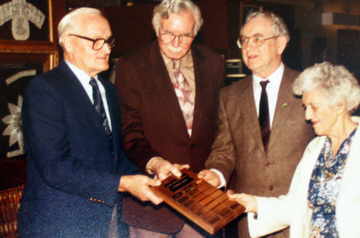My work life
The Surrey Delta Messenger
Bill Hastings and the staff of the SDM

In this picture Society President Leslie Eggleton is presenting a plaque to show the Society's appreciation for the donation of photograph collections. The donations included three extensive collections that were donated to the archives in 1982. Mr. Hastings, former publisher of the Surrey-Delta Messenger and photographer for White Rock Sun; Mr. McKinnon, former editor of The Surrey Leader; Mr. Curtis, former photographer for the Surrey Leader and later for the Langley Advance, donated their negatives and prints. Mrs. Amanda Curtis, wife of Neville Curtis, is accepting the plaque along with Bill Hastings and Stan McKinnon,
What's a "logo"?
Although I was recommended by my business machines teacher to work for a newspaper, I don't think you couldn't have chosen a more green and wet-behind-the-ears kid. What I was good at was using a keypunch machine. I loved spending my hour and a bit in class hammering away at a machine that was used for precisely punching holes into stiff paper cards at specific locations. When the card (keypunch card) was inserted into a reader, the information could be used. When I think of it now, it's very similar to the QR barcode of today. So simply, I loved inputting data, and to my knowledge I was the only one who did. Consequently, that made me the most likely choice to be a typesetter. In those days, the Friden Justowriter was the mainstay of modern newspapers. It was one step up from the cumbersome and dangerous hot lead machines of a decade prior. In fact, the second newspaper I worked in had a hot lead machine still there (as a backup).
It was here that I first learned the term "logo" and was given the task of creating a "logo" archive. These were small bits of paper with the local municipality of Surrey (not a city yet) on it, or an A&W logo, etc. They had on the other side of the paper, a thin film of wax, which would adhere to a paste-up sheet.
It was also here where I learned the term -30- (end of story).
There were a few of us girls from school who were hired on as typesetters. Some left within days. I stayed on with the remaining bunch. We were making less than $1.50 an hour, and after some back room cajoling, I was elected to enter Mr. Hastings office and ask for a raise for us all.
My knees were shaking and I was completely out of my league, but I did it. I asked for the raise. I was party to Mr. Hastings reddened face and outright rage. Shortly after that unsuccessful plea for better working conditions, he fired a few and a few left. And at the end of it all there were two of us left, and we received a raise.
The Surrey Delta Messenger's offices were actually just a small basement home in the heart of Whalley. Production was in the basement. The cold cellar was the darkroom, and the "rumpus" room served as a paste-up (composing) room, where three paste-up artists sliced and pasted the galleys of type and 65 line greyscale pictures.
The centre room was the archives, where all of the existing newspapers were stored, along with the all important "logo" archive.

The room where me and the other typesetter slammed out copy was a completely windowless room. It was freezing in the winter, and cool in the summer. As I type this, I do remember recruiting some friends and family to help learn to become typesetters. None of them stayed. It was a gruesome job, but I took to it like a duck to water. The endless clatter of the strip of coded paper, the smell of the darkroom chemicals - I loved it, even though at times it was terrifying. I was terrified of typos.
Upstairs was where the real action was. The salespeople, writers, circulation managers, secretary, editor and publishers all took up the bedrooms and main living room and dining room. The ktichen was the only room in the house which still served as its original purpose, simply — a kitchen.
Once, when there was no weekly picture to be the front page, I was recruited to climb the apple tree in the back yard and look, well, like a thief in an apple tree, I suppose. It was my one and only modeling job.
Years later, when Mr. Hastings sold the company, I stayed on. I remember, so sadly, being asked by the new publisher to get this particular story out, and out now. Which meant I had to drop what I was doing - something small but important job for Mr. Hastings. When he came into the room and asked whether it was done, and I revealed my new loyalties to the new boss, he was broken hearted and very upset. It upsets me to this day. Mr. Hastings was a good and honest man. He had a temper, and knew how to yell (typical of so many newspapermen) but he was always fair.